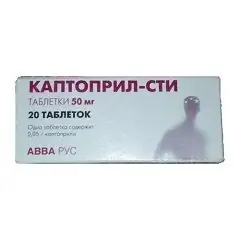- Author Rachel Wainwright [email protected].
- Public 2023-12-15 07:39.
- Last modified 2025-11-02 20:14.
Captopril-STI
Captopril-STI: instructions for use and reviews
- 1. Release form and composition
- 2. Pharmacological properties
- 3. Indications for use
- 4. Contraindications
- 5. Method of application and dosage
- 6. Side effects
- 7. Overdose
- 8. Special instructions
- 9. Application during pregnancy and lactation
- 10. Use in childhood
- 11. In case of impaired renal function
- 12. For violations of liver function
- 13. Use in the elderly
- 14. Drug interactions
- 15. Analogs
- 16. Terms and conditions of storage
- 17. Terms of dispensing from pharmacies
- 18. Reviews
- 19. Price in pharmacies
Latin name: Captopril-STI
ATX code: C09AA01
Active ingredient: Captopril (Captoprilum)
Manufacturer: AVVA RUS, JSC (Russia)
Description and photo update: 2019-12-07
Prices in pharmacies: from 29 rubles.
Buy

Captopril-STI is an angiotensin-converting enzyme (ACE) inhibitor.
Release form and composition
Dosage form - tablets: biconvex, white or white with a creamy tinge, possible slight marbling, a characteristic odor, on one side - with a risk (in a cardboard box 1 polymer can or bottle containing 60 tablets each, or 2, 3, 4, 5 or 6 packs of cell contour, containing 10 tablets, and instructions for the use of Captopril-STI).
Composition of 1 tablet of 25/50 mg:
- active substances: captopril - 25/50 mg;
- auxiliary components: talc - 1/2 mg; povidone K-17 - 1.975 / 3.95 mg; microcrystalline cellulose - 6.97 / 13.94 mg; corn starch - 7.98 / 15.96 mg; magnesium stearate - 1/2 mg; lactose monohydrate - to obtain a tablet weighing 100/200 mg.
Pharmacological properties
Pharmacodynamics
Captopril-STI is an ACE inhibitor that reduces the production of angiotensin II from angiotensin I, resulting in a direct decrease in aldosterone secretion. Against this background, post- and preload on the heart, blood pressure (BP), as well as the total peripheral vascular resistance decrease.
The pharmacological actions of the drug due to the properties of its active substance (captopril) also include:
- expansion of arteries (more than veins);
- an increase in prostaglandin synthesis and a decrease in the degradation of bradykinin;
- increased renal and coronary blood flow;
- decrease in the severity of hypertrophy of the walls of the myocardium and arteries of the resistive type (with prolonged use of the drug);
- improving the blood supply to the ischemic myocardium;
- decrease in platelet aggregation;
- decrease in Na + content in heart failure;
- lowering blood pressure without the development of reflex tachycardia (in contrast to direct vasodilators - minoxidil, hydralazine), leading to a decrease in myocardial oxygen demand.
The antihypertensive effect of Captopril-STI does not depend on the plasma renin activity, and a decrease in blood pressure against the background of its use is noted with a normal and even reduced hormone level, which leads to an effect on the tissue renin-angiotensin systems.
In patients with heart failure, taking angiotensin-converting enzyme inhibitors in an adequate dose has no effect on blood pressure.
After oral administration, the maximum decrease in blood pressure is observed after 1-1.5 hours. The duration of the antihypertensive effect depends on the dose of Captopril-STI and reaches optimal values for several weeks.
Pharmacokinetics
The absorption of captopril is fast and reaches 75%, however, with food intake, it decreases by an average of 30-40%. Its bioavailability varies from 35 to 40%, and its connection with blood plasma proteins, mostly albumin, is from 25 to 30%.
After 30-90 minutes after oral administration, the maximum concentration of captopril in blood plasma is reached - 114 ng per 1 ml. The substance weakly (<1%) penetrates the placental and blood-brain barriers. Its metabolism takes place in the liver with the formation of pharmacologically inactive metabolites of the disulfide dimer of captopril and captopril-cysteine disulfide.
The half-life of the drug is 3 hours. Excretion of 95% is carried out by the kidneys, while from 40 to 50% is excreted unchanged, and the rest - in the form of metabolites. The substance is secreted in breast milk. 4 hours after a single oral administration, the content of unchanged captopril in urine is 38%, in the form of metabolites - 28%, and after 6 hours it is found only in the form of metabolites. The content of unchanged captopril in daily urine is 38%, in the form of metabolites - 62%.
In patients with impaired renal function, the half-life of the drug varies from 3.5 to 32 hours. In chronic renal failure, captopril accumulates.
Indications for use
- chronic heart failure (CHF), as part of complex treatment;
- arterial hypertension, including the renovascular form;
- diabetic nephropathy in type 1 diabetes mellitus (with albuminuria above 30 mg / day);
- dysfunction of the left ventricle after myocardial infarction in clinically stable patients.
Contraindications
Absolute:
- angioneurotic edema that occurs during therapy with ACE inhibitors, including a history of data;
- severe liver / kidney dysfunction;
- stenosis of an artery of a single kidney or bilateral stenosis of the renal arteries with progressive azotemia;
- aortic stenosis and similar obstructive changes that impede blood flow;
- hyperkalemia;
- condition after kidney transplantation;
- pregnancy and the period of breastfeeding;
- age under 18;
- individual intolerance to the components of the drug and other ACE inhibitors.
Relative (Captopril-STI tablets are prescribed under medical supervision):
- cardiac ischemia;
- ischemia of the brain;
- inhibition of bone marrow hematopoiesis due to the likelihood of developing agranulocytosis and neutropenia;
- severe autoimmune pathologies (especially scleroderma or systemic lupus erythematosus);
- diabetes mellitus (due to an increased risk of hyperkalemia);
- primary hyperaldosteronism;
- conditions that are accompanied by a decrease in circulating blood volume, including vomiting and diarrhea;
- stay on hemodialysis;
- adherence to a diet with limited sodium content;
- elderly age.
Captopril-STI, instructions for use: method and dosage
Captopril-STI tablets are taken orally 60 minutes before meals. The dosage is determined by the doctor on an individual basis.
Recommended dosage regimen depending on indications:
- arterial hypertension: therapy begins with a minimum effective dose of 12.5 mg 2 times a day; in rare cases (including for elderly patients) - 6.25 mg 2 times a day. During the first hour after administration, it is important to monitor the patient's condition. When arterial hypertension develops, it should be transferred to a supine state. The development of such a response to the first dose should not be an obstacle to further treatment. The dose, if necessary, is gradually increased with an interval of 14-28 days until the optimal therapeutic effect is achieved. The usual maintenance dose for mild to moderate arterial hypertension is 25 mg 2 times a day; maximum - 50 mg 3 times a day (150 mg);
- heart failure: the initial dose is 6.25 or 12.5 mg 3 times a day, with a possible increase in the dose to 25 mg 3 times a day (if necessary). The maximum dose is 150 mg per day. Captopril-STI is prescribed in combination with diuretics or digitalis drugs. Before starting taking the drug, in order to avoid an initial excessive lowering of blood pressure, reduce the dose or cancel the diuretic;
- dysfunction of the left ventricle after myocardial infarction in patients who are in a clinically stable state: pills can be taken already 3 days after myocardial infarction in an initial dose of 6.25 mg per day. Further, the daily dose, depending on the tolerability of the drug, can be gradually increased to 37.5-75 mg, divided into 2-3 doses, or, if necessary, gradually increased to a maximum of 150 mg per day. A dose reduction may be required in cases of arterial hypotension. Further attempts to prescribe the maximum dose of Captopril-STI (150 mg per day) should be based on patient tolerance;
- diabetic nephropathy: 75 to 100 mg per day, divided into 2-3 doses. Patients with insulin-dependent diabetes with microalbuminuria (daily albumin excretion ranges from 30 to 300 mg) take 50 mg of Captopril-STI 2 times a day. If the total protein clearance exceeds 500 mg per day, taking the drug in a dose of 25 mg 3 times a day is effective.
In cases of moderate renal dysfunction (creatinine clearance - at least 30 ml per minute per 1.37 m 2), the drug is taken at 75-100 mg per day. Patients with a more pronounced degree of renal dysfunction (creatinine clearance <30 ml per minute per 1.73 m 2) start taking Captopril-STI with 12.5 mg per day (no more). In the future, if necessary, after a sufficiently long interval of time, the dose can be increased, but at the same time it should not exceed the daily dose used for the treatment of arterial hypertension. In addition, loop diuretics may be prescribed, rather than thiazide diuretics, if the clinician deems it appropriate.
Side effects
Possible adverse reactions [> 10% - very common; (> 1% and 0.1% and 0.01% and <0.1%) - rarely; <0.01%, including isolated messages - very rare]:
- cardiovascular system: peripheral edema, orthostatic hypotension, decreased blood pressure, tachycardia;
- nervous system: paresthesia, asthenia, fatigue, headache, dizziness;
- respiratory system: bronchospasm, pulmonary edema, dry cough;
- urinary system: deterioration of renal function (increased levels of creatinine and urea in the blood), proteinuria;
- water and electrolyte metabolism: acidosis, increased content of creatinine and urea nitrogen in the blood, proteinuria, hyponatremia (usually observed with a salt-free diet or with combination therapy with diuretics), hyperkalemia;
- digestive system: hepatitis (signs of hepatocellular damage), hyperbilirubinemia, increased activity of hepatic transaminases, diarrhea or constipation, dyspeptic symptoms, abdominal pain, nausea, stomatitis, dry mouth, impaired taste, loss of appetite; rarely - cholestasis; very rarely - pancreatitis;
- hematopoietic organs: agranulocytosis, thrombocytopenia, anemia, neutropenia;
- allergic reactions: lymphadenopathy, serum sickness, photosensitivity, fever, flushing of the skin of the face, angioedema, itching, skin rash (maculopapular, rarely bullous or vesicular); rarely - the appearance of anti-nuclear antibodies in the blood;
- others: general weakness.
Overdose
The main symptoms: thromboembolic complications, pronounced lowering of blood pressure up to collapse, acute cerebrovascular accident, myocardial infarction.
Therapy: the patient is placed in a horizontal position with raised legs, measures are taken to restore blood pressure (an increase in the volume of circulating blood, including intravenous administration of saline), and symptomatic treatment is carried out. Hemodialysis may be prescribed; peritoneal dialysis is not effective.
special instructions
Before you start taking Captopril-STI, as well as regularly during the period of therapy, it is important to monitor kidney function. With CHF, the drug is used under close medical supervision.
In 20% of cases, with long-term treatment with Captopril-STI, there is an increase in serum creatinine and urea, compared with the baseline or the norm, by more than 20%. In less than 5% of patients, especially with severe nephropathies, it is necessary to discontinue therapy due to an increase in creatinine.
In rare cases, taking pills for hypertension leads to severe arterial hypotension. The likelihood of its development increases with heart failure, salt and fluid deficiency (for example, after intensive diuretic therapy), as well as in patients on dialysis.
The risk of a sharp drop in blood pressure can be minimized in three ways:
- Preliminary withdrawal of the diuretic (4-7 days);
- Increased intake of sodium chloride (about 7 days before the start of taking the tablets);
- Application of the drug in initial doses not exceeding 6.25-12.5 mg per day.
The number of blood leukocytes in the first 3 months of therapy should be monitored monthly, then - once every 3 months; with autoimmune pathologies in the first 3 months - every 14 days, then - once every 2 months. If the number of leukocytes is <4000 per 1 μl, a general blood test is prescribed, when the indicator falls below 1000 per 1 μl, therapy is canceled.
Taking ACE inhibitors, including Captopril-STI, in some cases leads to an increase in serum K + concentration. With diabetes mellitus, renal failure, taking potassium-sparing diuretics, medicines containing potassium or drugs that increase the concentration of potassium in the blood (for example, heparin), the risk of hyperkalemia is increased. In this regard, it is recommended to avoid combined therapy with potassium-sparing diuretics and potassium preparations.
In cases of hemodialysis during the period of taking Captopril-STI, it is important not to allow the use of dialysis membranes with high permeability (for example, AN69), since in such cases the likelihood of developing anaphylactoid reactions increases.
When angioedema appears, the angiotensin-converting enzyme inhibitor is canceled, the patient is under close medical supervision and symptomatic treatment is prescribed.
It should be borne in mind that the result of urine analysis for acetone during the period of taking captopril may be false positive.
Patients on a low-salt or salt-free diet should take Captopril-STI with caution, due to the increased risk of arterial hypotension.
Influence on the ability to drive vehicles and complex mechanisms
Since taking Captopril-STI can lead to the development of dizziness (especially after taking the initial dose), patients during the period of therapy are advised to refrain from driving and conducting potentially hazardous activities.
Application during pregnancy and lactation
Captopril-STI is not prescribed during pregnancy / breastfeeding.
Pediatric use
Captopril-STI is not prescribed for patients under 18 years of age.
With impaired renal function
The appointment of Captopril-STI is contraindicated in patients with severe renal impairment, stenosis of an artery of a single kidney with progressive azotemia or bilateral stenosis of the renal arteries, as well as in the period after kidney transplantation.
For violations of liver function
In case of severe violations of liver function, taking the drug is contraindicated.
Use in the elderly
Captopril-STI is used in elderly patients under medical supervision.
Drug interactions
Possible interactions of captopril with other substances / drugs:
- digoxin: its concentration in blood plasma increases by 15-20%;
- propranolol: its bioavailability increases;
- cimetidine: increases the concentration of captopril in the blood plasma by slowing down the metabolism in the liver;
- non-steroidal anti-inflammatory drugs: the hypotensive effect of the drug is weakened (a decrease in prostaglandin synthesis and sodium retention);
- ethanol, tricyclic antidepressants, β-blockers, verapamil, minoxidil (vasodilators), thiazide diuretics: the hypotensive effect of captopril is enhanced;
- lithium preparations: their excretion slows down;
- salt substitutes, potassium supplements, cyclosporine, potassium preparations, potassium-sparing diuretics: the likelihood of hyperkalemia increases;
- flecainide, allopurinol, procainamide: the likelihood of developing an immunosuppressive effect increases;
- probenecid: urinary excretion of the drug slows down;
- clonidine: the severity of the hypotensive effect of the drug decreases;
- cyclophosphamide, azathioprine (immunosuppressants): the risk of hematological disorders increases.
Analogs
The analogues of Captopril-STI are Captopril-FPO, Angiopril-25, Captopril, Blockordil, Captopril Sandoz, Vero-Captopril, Captopril-Ferein, Capoten, Captopril-AKOS, Captopril-UBF, Captopril-Sar, Captopril Velpharm.
Terms and conditions of storage
Store in a place protected from light and moisture at temperatures up to 25 ° C. Keep out of the reach of children.
The shelf life is 3 years.
Terms of dispensing from pharmacies
Dispensed by prescription.
Reviews about Captopril-STI
According to reviews, Captopril-STI is a safe, effective, fast-acting and affordable drug used for high blood pressure.
Price for Captopril-STI in pharmacies
The approximate price for Captopril-STI, 50 mg tablets, is: 40 pcs. in a package - 52 rubles, 20 pcs. in the package - 41 rubles.
Captopril-STI: prices in online pharmacies
|
Drug name Price Pharmacy |
|
Captopril-STI 50 mg tablets 20 pcs. RUB 29 Buy |
|
Captopril-sti tablets 50mg 20 pcs. 34 rbl. Buy |
|
Captopril-STI 50 mg tablets 40 pcs. RUB 44 Buy |
|
Captopril-sti tablets 50mg 40 pcs. RUB 58 Buy |

Anna Kozlova Medical journalist About the author
Education: Rostov State Medical University, specialty "General Medicine".
Information about the drug is generalized, provided for informational purposes only and does not replace the official instructions. Self-medication is hazardous to health!






